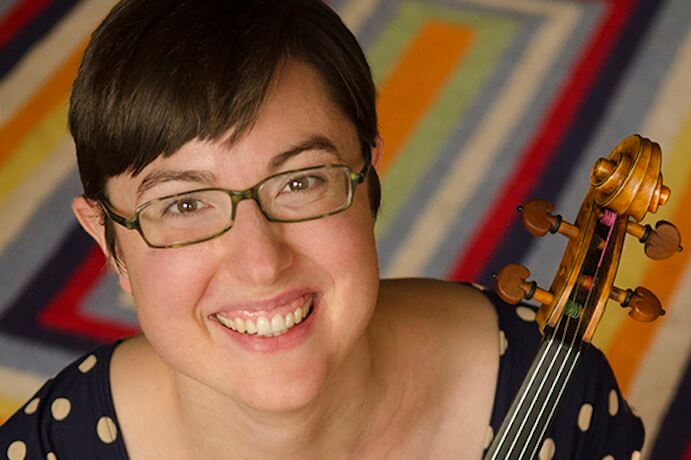The six works presented on the self-titled album Trios for Two, a 2017 Innova release by Danny Holt and Molly Gebrian, are all world premiere recordings. The musicians are Molly Gebrian on viola and Danny Holt playing an instrument setup he conceived himself, an amalgamation of piano and percussion ensemble (including drum kit, additional cymbals, gongs, triangle, xylophone). He plays piano and percussion instruments simultaneously–somehow–and switches between them imperceptibly.
Unsurprisingly, each piece on Trios for Two is commissioned for the skilled duo, as repertoire for such an ensemble didn’t exist until Gebrian and Holt began their collaboration in 2010. The minimalist yet jaunty Theatric No. 8 by Casey Cangelosi opens the album, followed by the five, short movements of Second Take by Karl Blench, and both heavily showcase Danny Holt.

Holt is featured until the album’s eighth track, Third Nature by Christopher Goddard. According to the liner notes, Third Nature is written as “…a drama with three (or only two?) different characters.” It’s unclear if three characters are truly developed in the piece, but the musicians certainly bring out its conversational qualities. Gebrian’s sensitivity and superior relationship with her instrument is beyond apparent in Third Nature, at moments during which the viola sounds not unlike a human voice.
While Holt’s innovative instrument demands virtuosic musicianship, the simultaneous virtuosity of Gebrian’s viola refuses to go unnoticed, particularly on the second half of Trios for Two. Lucky for her, the closing two pieces are also the album’s most compelling.
Ingrid Lee’s Nomentum, the penultimate piece, blends the percussion instruments most seamlessly into the composition. Lee has written extended techniques for both percussion and viola into the piece to simulate electroacoustic sounds made by acoustic instruments. Like Goddard, Lee carefully uses Holt’s piano/percussion as both rhythmic accompaniment and narrative agent. Often, Holt impressively performs the two concepts at once: piano accompanying viola and percussion, and then later, percussion accompanying viola and piano.

In the album’s starkest contrast, the last piece, Black and White by Chiayu, explores the relationship between Yin and Yang, and, per the liner notes “the concept that Yin and Yang are contrary forces, but at the same time they complement…one another.” The piece begins with “White,” a movement that uses very limited percussion, and the album’s most tonal track. While Gebrian oscillates between extremes of the viola’s registers, Holt provides rounded, harmonic and temporal support on the piano, with sparse and consonant accents from his tonal percussion instruments to add tension. “Black,” then, is much pricklier, where the viola and piano trade angular motivic developments alongside an unrelenting percussion. “Black” shares some musical material with “White,” but the styles are appropriately the inverse of each other.
Trios for Two is representative of the kinds of new works that can be written for innovative musical projects, and those works deftly showcase each musician’s dynamic skill and musicality. At just over an hour, the album’s tracks are an interesting variety of works that don’t become stagnant. One can imagine that seeing the duo live would be a treat, but the album itself does not disappoint.
























